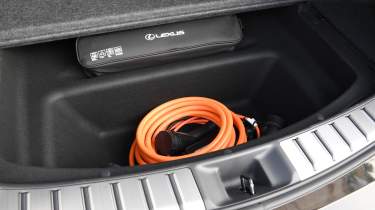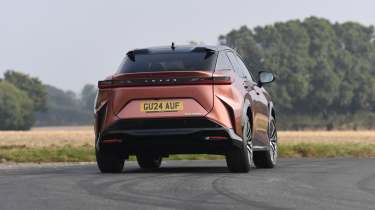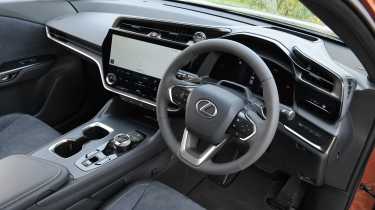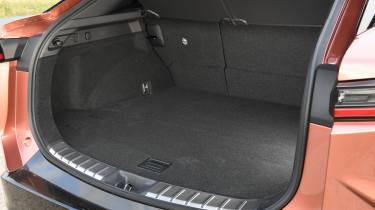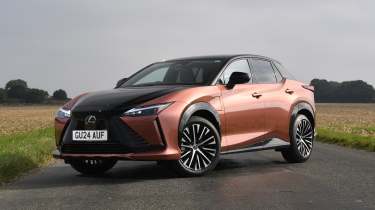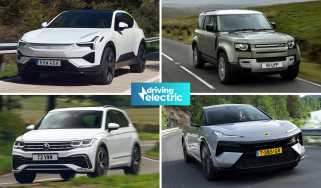Lexus RZ review
The Lexus RZ is a plush and practical electric SUV, although this seems to come at the cost of efficiency
Pros
- Well-finished cabin
- Comfortable
- Lexus' customer satisfaction
Cons
- Unengaging drive
- Feels derivative
- Rivals offer more range
Lexus RZ verdict
The Lexus RZ is a crucial model for the Japanese manufacturer, but we feel it struggles to bring anything new or interesting to this competitive market segment. The RZ’s cabin feels well built, if not luxurious, and a supremely comfortable ride makes it perfect for pottering around town or doing the school run. However, it’s difficult to escape the fact the mechanically-similar Toyota bZ4X is cheaper, despite offering a longer range than its premium sibling.
Range details, specs and alternatives
Lexus has long been a purveyor of electrification. Since the original RX 400h debuted in 2005 as the brand’s first hybrid car, almost every new Lexus model has been offered with some kind of electrified powertrain. With this in mind, you may be surprised that it took so long for the Japanese luxury car manufacturer to come out with its first purpose-built electric car: the Lexus RZ, but the premium electric SUV did eventually arrive in 2022.
The Lexus RZ shares its e-TNGA platform underpinnings with the more mainstream Toyota bZ4X, as well as the more rugged Subaru Solterra. The RZ is primarily intended to rival other premium offerings such as the BMW iX3, Audi Q6 e-tron and Porsche Macan Electric. Lexus is also attempting to lure buyers away from more mainstream options like the Tesla Model Y, Nissan Ariya and Volkswagen ID.4.
There are two powertrains to choose from for the Lexus RZ. The entry-level RZ 300e was launched in 2024, and brought boosted battery range and a lower starting price to the line-up. The 300e is powered by a single front-mounted motor producing 201bhp, and this is fed by a 71.4kWh (64kWh usable) battery pack, which can return up to 297 miles on the WLTP combined cycle.
The more powerful (and more expensive) RZ 450E adds in a second rear-mounted motor for four-wheel drive and an increased power output of 309bhp. This model shares the same 71.4kWh battery as the 300e, but its maximum range is reduced to 273 miles.
One of the headline features of the RZ was set to be its unique optional ‘ONE MOTION GRIP’ steer-by-wire system, but this won’t be available until at least 2025. We’ll get into what that means a bit further into this review.
As standard, the RZ comes equipped with 150kW ultra-rapid DC charging capability which, according to Lexus, will be able to top-up the car’s battery from 10-80% in under half an hour if you’re connected to a sufficiently powerful public charger.
Buyers can choose from one of three trim levels: Premium, Premium Plus and Takumi. As you’d expect from a Lexus, the RZ comes with plenty of standard equipment, with all cars getting LED exterior lighting, 18-inch alloy wheels, full leather upholstery, a 14-inch touchscreen, heated seats and a heated steering wheel, a panoramic sunroof and Lexus’ Safety System+ suite of driver aids.
Stepping up to the mid-spec Premium Plus adds larger 20-inch alloys, more-efficient ‘radiant’ cabin heaters, a head up display and upgraded steering wheel controls. Finally, the range-topping Takumi boasts unique fabric upholstery, a Mark Levinson stereo, 64-colour ambient lighting and an electronically dimmable sunroof.
Range, battery size & charging
| Model | Range | Wallbox charge time | Rapid charge time |
| RZ 300e | 297 miles | 10hrs (0-100%, 7.4kW) | 25mins (10-80%, 150kW) |
| RZ 450e | 273 miles | 10hrs (0-100%, 7.4kW) | 25mins (10-80%, 150kW) |
Both variants of the Lexus RZ are powered by a 71.4kWh (64kWh usable) battery pack, but the SUV’s maximum range depends on the chosen powertrain and the chosen wheel size.
If you want the most range, the good news is that you’ll actually spend less as it’s the entry-level RZ 300e in base Urban trim which offers the largest official figure. This RZ covers up to 297 miles on the WLTP combined cycle thanks to its single motor and smaller 18-inch alloy wheels.
If you want the front-wheel drive RZ 300e but in a higher trim level, the Premium, Premium Plus and Takumi models all see the range figure drop to 268 miles, due to the larger 20-inch wheels.
Moving up to the four-wheel drive RZ 450e, this delivers a range of up to 273 miles on the WLTP combined cycle. However, just like the smaller 300e, moving up the trim levels takes its toll on the battery, with the plushest models achieving a maximum claimed range of 251 miles.
We ran the RZ 450e on the DrivingElectric fleet for a while and only managed an average of around 3.0 miles per kilowatt-hour, which translates to a pretty disappointing figure of around 200 miles – roughly the same as what you’d get in an electric supermini like the Vauxhall Corsa Electric.
Thankfully, every Lexus RZ gets 150kW ultra-rapid DC charging as standard, meaning you’ll be back on the road in around 30 minutes if you manage to find a public charger compatible with these speeds. Plugging into a 7.4kW wallbox will take substantially longer – a full charge will be completed in around 10 hours. Using a standard three-pin plug will take over a day, although this should only be a last resort.
Running costs & insurance
Starting at over £50,000, the Lexus RZ is not only pricey to buy, it’s pretty pricey to insure, too. Depending on which version you pick, the RZ occupies the relatively high groups 39 to 45. In comparison, the BMW iX3 sits in group 44.
Other running costs should be much easier to swallow. Charging the RZ at home overnight can be much cheaper than filling up the equivalent petrol or diesel luxury SUV – especially if you’re subscribed to a specific EV electricity tariff. That said, the RZ is far from the one of the most efficient electric cars on sale, so you’ll be spending quite a lot to cover a relatively short distance – especially if you make use of public rapid chargers which can cost as much, if not more than filling up with petrol.
Like all electric cars, the Lexus RZ sits in the low 2% Benefit in-Kind (BiK) tax bracket for company car drivers and is exempt from road tax (VED) until april 2025. Buyers will also escape having to pay out for emissions-based charges, such as the London ULEZ, for the foreseeable future.
Performance, motor & drive
| Model | 0-62mph | Top speed | Driven Wheels | Power |
| RZ 300e | 8 seconds | 99mph | Front | 201bhp |
| RZ 450e | 5.6 seconds | 99mph | Four | 309bhp |
Both the RZ 300e and 450e offer a decent amount of performance shove, but the general focus is placed on comfort rather than sportiness. This is no bad thing, though, when you remember that this is meant to be a refined and upmarket SUV.
The less powerful, front-wheel drive 300e still produces a reasonable 201bhp and 266Nm of torque. While it isn’t going to win too many drag races against its EV rivals, this version of the RZ will accelerate from 0-62mph in exactly 8 seconds and then proceed on to a top speed of 99mph.
The four-wheel drive 450e shares the same 99mph top speed, but its dual motors bump up the power to 309bhp and 435Nm of torque. This reduces the landmark sprint time down to 5.6 seconds, which isn’t bad for a car that weighs over two tonnes.
Power in the RZ 450e is managed by Lexus’ Direct4 system, which analyses your current g-forces, wheel speed etc. and subsequently juggles the car’s power between the front and rear axles in order to maintain maximum traction.
Both versions of the RZ also feature Lexus’s steer-by-wire system, which means there’s very little feedback through the wheel. However, the Lexus offers a decent amount of grip in corners, and its body weight is kept well in check. As a result, the RZ generally feels stable on a twisty road. However, it ultimately fails to offer a more dynamic drive than its less-expensive siblings, the Toyota bZ4X and Subaru Solterra.
This lack of outright fun could, in theory, be at least partly rectified in the future by the arrival of the Japanese brand’s new steer-by-wire system, dubbed ‘ONE MOTION GRIP’. Controlled via a jet-fighter style ‘yoke’ steering wheel – cars without this system get a traditional circular wheel – ONE MOTION GRIP aims to offer sharper, more direct steering at lower speeds, and more precise inputs when going fast. We don’t expect this to arrive as an option before 2025, though.
Truth be told, most SUV buyers aren’t after a sporty drive and primarily want comfort – something the Lexus RZ offers in spades. When on the move, it’s incredibly refined and manages to soak up the majority of bumps well. There’s very little wind noise, too, although we suspect our test car’s tyre roar was a result of its optional 22-inch alloy wheels.
Interior, dashboard & infotainment
We were impressed with the Toyota bZ4X’s interior when the car first debuted, as it marked a vast improvement over the cheap-feeling Toyota cabins of old. Given the Lexus RZ shares many of that car’s parts and costs around thousands of pounds more, we expected big things from the supposed ‘luxury’ variant.
So, were we equally wowed by the Lexus? Yes and no. If you’re familiar with other recent Lexus models, you’ll immediately feel at home in the RZ. The overall design of the cabin is classy yet understated, and while there is no glove box on top-spec models to make way for the energy-efficient ‘radiant heaters’, everything is otherwise laid out in a thoughtful manner.
It’s worth noting, though, that even our top-spec Takumi test car – which has a starting price of over £60,000 – felt well-built rather than truly luxurious; a Genesis Electrified GV70 will ultimately provide more of a sense of occasion, despite being based on a petrol SUV.
Lexus has long lagged behind rivals when it comes to cutting-edge infotainment technology, until recently fitting its cars with a clunky touchpad-based media system. Thankfully, this is nowhere to be seen in the RZ, with all versions getting a glossy 14-inch touchscreen with integrated physical climate control dials.
Identical to the system fitted to the hybrid-powered Lexus RX, this slick and easy-to-use unit comes as standard with Apple CarPlay and Android Auto connectivity, and is bolstered by a small digital instrument cluster behind the steering wheel. We wish the latter was a tad more configurable, though.
Boot space, seating & practicality
| Length | Width | Height | Boot volume (seats up/down) |
| 4,805mm | 1,895mm | 1,635mm | 522/1,451 litres |
Despite its sloping roofline, the Lexus RZ offers more than enough space for most families. Two adults can stretch out in the rear with sufficient head and legroom, while a third occupant can also sit in relative comfort, thanks to a flat cabin floor. One odd omission is that of a glovebox; while you’re probably not still lugging around an A-Z road map these days, this does somewhat limit what items you can store in the cabin.
There’s also no ‘frunk’ under the bonnet, either, although we think the majority of buyers should be adequately served by the RZ’s 522-litre boot, too. This is larger than the BMW iX3’s 510 litres, but it falls ever-so-slightly short of the Audi Q6 e-tron’s 526 litres. If you don’t need to use the Lexus’s rear seats, these can be folded down to provide a cavernous 1,451 litres of space.
Reliability & safety rating
Just like its parent company Toyota, Lexus has a pretty solid reputation when it comes to reliability. Seeing as EVs have fewer moving parts than combustion cars, we’d expect the Lexus RZ to prove pretty robust in the longer term.
None of the brand’s cars appeared in our 2024 Driver Power customer satisfaction survey, but the brand placed 12th out of 32 brands in our best manufacturer rankings.
As you’d expect from a Lexus, the RZ was granted a full five-star safety rating by Euro NCAP. All models come as standard with Lexus’ full Safety System+ suite of driver aids that includes autonomous emergency braking (AEB), lane-departure warning, lane-keep assist, blind spot monitoring, adaptive cruise control and automatic high beams. These, while effective, are rather nannying at times, and we sometimes felt inclined to turn them off.



